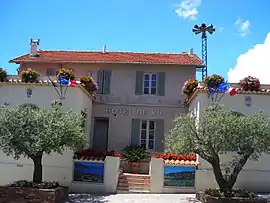La Croix-Valmer
La Croix-Valmer is a commune in the Var department in the Provence-Alpes-Côte d'Azur region in southeastern France.
La Croix-Valmer | |
|---|---|
 The town hall of La Croix-Valmer | |
.svg.png.webp) Coat of arms | |
Location of La Croix-Valmer 
| |
 La Croix-Valmer  La Croix-Valmer | |
| Coordinates: 43°12′31″N 6°34′08″E | |
| Country | France |
| Region | Provence-Alpes-Côte d'Azur |
| Department | Var |
| Arrondissement | Draguignan |
| Canton | Sainte-Maxime |
| Government | |
| • Mayor (2020–2026) | Bernard Jobert[1] |
| Area 1 | 22.28 km2 (8.60 sq mi) |
| Population (2017-01-01)[2] | 3,780 |
| • Density | 170/km2 (440/sq mi) |
| Time zone | UTC+01:00 (CET) |
| • Summer (DST) | UTC+02:00 (CEST) |
| INSEE/Postal code | 83048 /83420 |
| Elevation | 0–369 m (0–1,211 ft) (avg. 100 m or 330 ft) |
| 1 French Land Register data, which excludes lakes, ponds, glaciers > 1 km2 (0.386 sq mi or 247 acres) and river estuaries. | |
Geography

La Croix-Valmer is at the foot of the Massif des Maures hills in the Bay of Cavalaire-sur-Mer, halfway between Le Lavandou and Saint-Tropez.
History
The Emperor Constantine the Great, on the way to wage war against his brother-in-law Maxentius in 312 AD, is said to have had a vision of a cross in the sky stating "in hoc signo vinces" (by this sign you will conquer) at the location where La Croix-Valmer is now situated. On April 16, 1893, a stone cross was erected on the site where tradition holds this vision occurred. La Croix-Valmer became a commune on 6 April 1934, separating from the commune of Gassin.
The area has been inhabited since ancient times, as demonstrated by the discovery of remains such as prehistoric tools, cists, and the Roman farm of Pardigon (dating from the third century BC).
During the Second World War, the beaches of La Croix-Valmer were part of the Allied invasion of Provence during Operation Dragoon. The name of one of the local beaches, Plage du Débarquement ("Landing Beach"), bears witness to this.
Abel Faivre (1853-1945), a French painter, lived in La Croix Valmer, near the Gigaro beach.
References
- "Répertoire national des élus: les maires". data.gouv.fr, Plateforme ouverte des données publiques françaises (in French). 2 December 2020. Retrieved 7 December 2020.
- "Populations légales 2017". INSEE. Retrieved 6 January 2020.
| Wikimedia Commons has media related to La Croix-Valmer. |